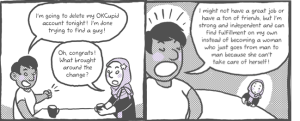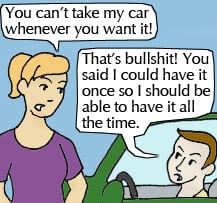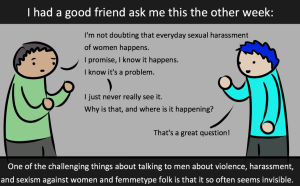
Credit: Getty Images
One-in-three adolescents in the United States is a victim of abuse at the hands of an intimate partner.
Let me repeat that: One-third of teenagers in dating relationships are being abused by their partners.
One-third.
And that’s a lot considering that over 70% of teenagers are dating.
Abusive behaviors – like guilt-tripping and limiting outside involvement with other people – are often justified using “jealousy” as an excuse, and possessive discourse runs rampant as a sign of affection.
After all, if what I see being reblogged by teens on Tumblr is any indication, you’re supposed to have 24/7 access to your partner’s social media platforms and technology. You’re supposed to feel unreasonable anger when another girl writes on your boyfriend’s Facebook wall. It’s normal to put down verbally any guy who flirts with your girlfriend and then restrict her contact with him.
Because your partner belongs to you.
Apparently.
Because, hey, what the media is selling is that manipulation and control are signs of a healthy relationship, and persevering through rough waters, waiting for loved ones to change their behavior, is commendable. Seriously. Just listen to the radio.
And this normalization – by way of media and peers – is largely why only one-third of teenagers in abusive relationships are reporting the abuse.
Parents – of whom, by the way, only 19% recognize that teen dating violence is an issue – and teachers, while not to blame, can’t fix the problem – especially if they refuse to acknowledge that there is one.
Writing violence off as growing pains – “Of course my daughter is in her room crying again!” “Of course couples push each other against the walls in the hallways between classes!” “Ahh, young love!” – is not only ridiculous; it’s dangerous.
Dating patterns are established early. What that means is that the relationship styles and cycles that you find yourself in when you’re young usually stick with you. And that’s bad news considering, according to Love Is Respect, “the severity of intimate partner violence is often greater in cases where the pattern of abuse was established in adolescence.”
This isn’t just kids being kids. This is people who are coming of age accepting abuse as normal, paving the way for a lifetime of danger.
And when you consider that “girls and young women between the ages of 16 and 24 experience the highest rate of intimate partner violence — almost triple the national average,” we need to see a change.
But before we can see a change, we need to see a problem.
And because teen dating violence has been so normalized, we really need to start at the basics.
1. Physical Abuse
Nearly 1.5 million high school students nationwide experience physical abuse from a dating partner in a single year.
And 1-in-10 high school students have been purposely hit, slapped, or otherwise physically hurt by a partner.
You’d think that this one is easy to spot.
Ask any person to list off examples of physical abuse, and they come up with plenty right away. The offenses flow off of their tongues as if you’d asked them to recite the alphabet: hitting, kicking, punching, scratching, biting, strangling.
Yes.
But this can also look like pushing you in the hallway, grabbing your face to make you look at them, blocking an exit so that you can’t leave, smacking your ass without your consent, and throwing things at or around you – things that can look playful or “not that bad” to outsiders.
But if it causes you discomfort, shame, or fear, then it’s not okay, it’s not healthy, and it’s not love.
2. Emotional Abuse
Growing up a teenager in my parents’ house, I was taught this very basic principle about dating: If he ever hits you, leave.
And that’s all good and well, except for that when I ended up in an emotionally abusive relationship, I was entirely unequipped to understand it.
No one ever told me “If he ever threatens to cut himself unless you do something for him, or if he ever blames you for everything that goes wrong to the point that you fall apart crying, or if he tells you that your relationship needs to be a secret because he doesn’t want anyone to know that he’s stooped low enough to date you, leave.”
No one ever told me that.
I wish someone had.
Emotional abuse – also often called psychological or verbal abuse – is often the first warning sign that something is amiss in a relationship.
Behaviors such as threats, insults, constant monitoring, excessive texting, humiliation, intimidation, isolation, and stalking all fall under this category.
The problem is: Without a bruise that you can physically see, it can be a lot harder to recognize this one.
Does your partner call you names or use other put-downs, rather than paying you kind attention and uplifting you? Does your partner think it’s appropriate to yell or scream at you, rather than speak to you calmly and respectfully? Does your partner intentionally embarrass you in public or in front of your family or friends as a means to control your behavior?
Emotional abuse.
Does your partner prevent you from seeing or talking with people, especially people that threaten them, like ex-partners? Does your partner tell you what you can and cannot wear, or otherwise make it clear that they either approve or disapprove of your outfits? Does your partner show up places when you’re not expecting – or even wanting – to see them?
Emotional abuse.
Using threats of suicide to manipulate you, causing harm to your pets, destroying your personal belongings, starting rumors about you, and threatening to out you or otherwise spread your secrets?
Emotional abuse.
And yes – it’s serious.
Part of the problem with emotional abuse in particular is that “constantly being criticized and told you aren’t good enough causes you to lose confidence and lowers your self-esteem. As a result, you may start to blame yourself for your partner’s abusive behavior.”
In reality, your partner is using these tactics to assert power and control over you.
And when only one partner in the relationship has control, it’s abuse.
3. Sexual Abuse
Date rapes account for almost 70% of sexual assaults reported by adolescent and young women, and 38% of those women are between the ages of 14 and 17.
Additionally, approximately 70% of college students say that they have been sexually coerced.
And maybe this shouldn’t be so surprising considering that marital rape was considered perfectly legal in the United States until the mid-1970’s and wasn’t officially a crime in all 50 states until 1993.
But does anyone else see a problem with how often women are forced into sex by the very people that they’re supposed to trust?
But sexual abuse goes beyond just rape. Forced sex isn’t the only way to control a partner’s sexual expression.
Unwanted kissing or touching, nonconsensual rough or violent sex, or using sexual insults (dyke, slut, etc.) are other forms of sexual abuse.
Forcing you to have sex with others, forcing you to have sex in front of others, recording (and possibly distributing) videos of your sexual activity without your consent, and sending unsolicited (or pressuring you to send) explicit pictures or text messages is also sexual abuse.
As is what we call “birth control sabotage” – when a partner refuses to use condoms or otherwise restricts someone’s access to birth control. So that means that if your partner tells you that you “can’t” take birth control pills or that you “can’t” get an abortion, or otherwise restricts your access to these resources and services, it’s sexual abuse.
Sexual abuse isn’t always physically violent. It’s as simple as the absence of a yes or thinking that “no” translates to “convince me.”
Each person has the right to decide when and how they want to have sex. And when that right is infringed upon repeatedly by a dating partner, it isn’t “boys being boys” or “girls being nymphos.” It’s sexual abuse.
4. Financial Abuse
I once dated someone who really didn’t make a lot of money. And by “really didn’t make a lot of money,” what I mean is “was unemployed.”
This didn’t faze me. We could still go out for dinners, take trips from Atlanta to my parents’ house in Maine, and go on extravagant adventures. I had enough money for it, and I was in love.
But this really, really bothered her.
And it wasn’t until relatively recently that I realized why: Even though it was a result of our circumstances and not by active – and certainly not manipulative – choice, having all of the control of finances in our relationship gave me a lot of power.
And what could feel nice – like having someone pay for your dinner – can turn pretty dangerous pretty quickly, like refusing to pay for your food, rent, medicine, or clothing unless you adhere to certain rules.
But if your partner takes your paychecks, limits your access to your bank account, or hides your financial aid check, we’ve got a problem on our hands.
Just like we do if your partner limits the number of hours you can work (or doesn’t let you work at all), prevents you from going to work (by taking your car keys or bus fare), or gets you fired.
In short: If your partner interferes with or controls your finances, then you may be in an unhealthy or abusive relationship.
After all, one of the easiest ways to keep someone in an abusive relationship is to ensure that you can’t leave the relationship – and knowing you’d be broke without the financial support of your partner is one way to trap you.
5. Digital Abuse
Over one-quarter of teenagers in relationships report experiencing digital abuse, which emphasizes the role that technology plays not only in adolescents’ lives, but in their abusive relationships as well.
Digital abuse – which is the use of technologies such as texting and social networking to bully, harass, stalk, or intimidate a partner – is a huge violation of respectful relationship boundaries and presents extra layers of difficulty.
For example, while a substantial amount of violent incidents in teen relationships occur on school grounds, the pervasiveness of technology in teens’ lives makes it easier for the abuse to be non-stop. Teenagers go to sleep and wake up to their cell phones – and in some cases, also to abuse.
And if the bulk of the abuse is happening – literally! – in their hands, how is anyone supposed to notice and consequently intervene?
Not to mention, how are teens supposed to get help if many adults don’t “get” technology and therefore don’t notice inappropriate behavior?
But if your partner controls who you follow and are friends with on social media sites, puts you down or embarrasses you in their updates, or sends you negative, insulting, or threatening messages, that’s emotional abuse in online form.
Similarly, incidents of stalking can happen online, too. I know we like to joke about – haha! – “Facebook stalking,” but it’s a real phenomenon that can cause legitimate harm to people. Using apps like Foursquare to keep constant tabs on you or constantly texting you to the point that you feel like you can’t be away from your phone for fear of punishment are very real, very intimidating forms of psychological violence.
And if your partner is constantly looking through your phone – checking up on your pictures, your texts, your incoming and outgoing calls – or steals or insists to be given access to your online passwords, then what they’re doing isn’t being adorably jealous – they’re invading your privacy.
And any time that a partner disrespects your personal boundaries and right to privacy, it’s a major red flag.
So Now What?
It’s easy enough to read an article like this and say, “Psh, if I were in that situation, I would leave!” But that line of thinking points to a clear lack of understanding of how abuse works.
This isn’t the same as an unhealthy, unhappy relationship where someone can finally decide to break up, leave, and move on. This is a situation where someone fears for their well-being. After all, the most dangerous time for a person who is being abused is when they try to leave. It’s when they’re most likely to be killed.
Leaving, though seemingly the best idea, isn’t always the best option for someone in an abusive relationship. Sometimes they just want to talk to a professional about the abuse. And sometimes they might want to obtain a protection order. But sometimes what they really need is to know that someone will support them.
A safety plan – a personalized and practical plan that can help you avoid dangerous situations and know the best way to react when you’re in danger – is a really empowering and necessary tool for anyone in an unhealthy or abusive relationship. You can create one for yourself or you can sit down with someone else to make one.
And if you’re not sure how else you can support a loved one who is experiencing intimate partner violence, this article should give you a place to start.
What’s most important for you – as either a survivor or a friend of a survivor – to know is that there are options out there and that anything a survivor chooses to help themselves is a good choice.
Hopefully someday, we’ll put a stop to teen dating violence.
In the meantime, let’s recognize that it’s a serious issue and do our best to arm ourselves with knowledge and to empower ourselves to make the safest choices.
Want to discuss this further? Login to our online forum and start a post! If you’re not already registered as a forum user, please register first here.
Melissa A. Fabello, Editor of Everyday Feminism, is a domestic violence prevention and sexuality educator, eating disorder and body image activist, and media literacy vlogger based out of Philadelphia. She enjoys rainy days, Jurassic Park, and the occasional Taylor Swift song and can be found on YouTube and Tumblr. She holds a B.S. in English Education from Boston University and an M.Ed. in Human Sexuality from Widener University. She can be reached on Twitter @fyeahmfabello. Read her articles here and book her for speaking engagements here.
Search our 3000+ articles!
Read our articles about:
Our online racial justice training
Used by hundreds of universities, non-profits, and businesses.
Click to learn more




















